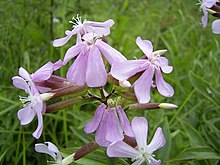| Saponaria officinalis | |
|---|---|

| |
| Scientific classification | |
| Kingdom: | Plantae |
| Clade: | Tracheophytes |
| Clade: | Angiosperms |
| Clade: | Eudicots |
| Order: | Caryophyllales |
| Family: | Caryophyllaceae |
| Genus: | Saponaria |
| Species: | S. officinalis
|
| Binomial name | |
| Saponaria officinalis | |
| Synonyms[1] | |
| |

Saponaria officinalis is a common perennial plant from the family Caryophyllaceae. This plant has many common names,[2] including common soapwort,[3] bouncing-bet,[3] crow soap,[2] wild sweet William,[2] and soapweed.[4] There are about 20 species of soapworts altogether.
The scientific name Saponaria is derived from the Latin sapo (stem sapon-) meaning "soap", which, like its common name, refers to its utility in cleaning. From this same Latin word is derived the name of the toxic substance saponin, contained in the roots at levels up to 20 percent when the plant is flowering[5] (Indian soapnuts contain only 15 percent). It produces a lather when in contact with water. The epithet officinalis indicates its medicinal functions. It is a common host plant for some moth species, including the white-lined sphinx.[6]
Saponaria officinalis' native range extends throughout Europe, and in Asia to western Siberia. It grows in cool places at low or moderate elevations under hedgerows and along the shoulders of roadways. It can be found as a horticultural escape and noxious invasive in much of North America.[7]
- ^ "Saponaria officinalis L.". World Checklist of Selected Plant Families. Royal Botanic Gardens, Kew – via The Plant List. Note that this website has been superseded by World Flora Online
- ^ a b c "Saponaria officinalis". Plant Selector. Royal Horticultural Society. 2002.
- ^ a b "Saponaria officinalis". Germplasm Resources Information Network. Agricultural Research Service, United States Department of Agriculture. Retrieved 22 December 2017.
- ^ Slichter, Paul. "The Pink Family in the Columbia River Gorge: Caryophyllaceae".
- ^ Hiltunen, Raimo; Holm, Yvonne. Farmakognosia (in Finnish). Helsinki University Press.
- ^ "White-lined Sphinx Hyles lineata (Fabricius, 1775)". Butterflies and Moths of North America. Retrieved 2017-11-14.
- ^ Chayka, Katy; Dziuk, Peter (2016). "Saponaria officinalis (Bouncing Bet)". Minnesota Wildflowers. Retrieved 2017-12-29.